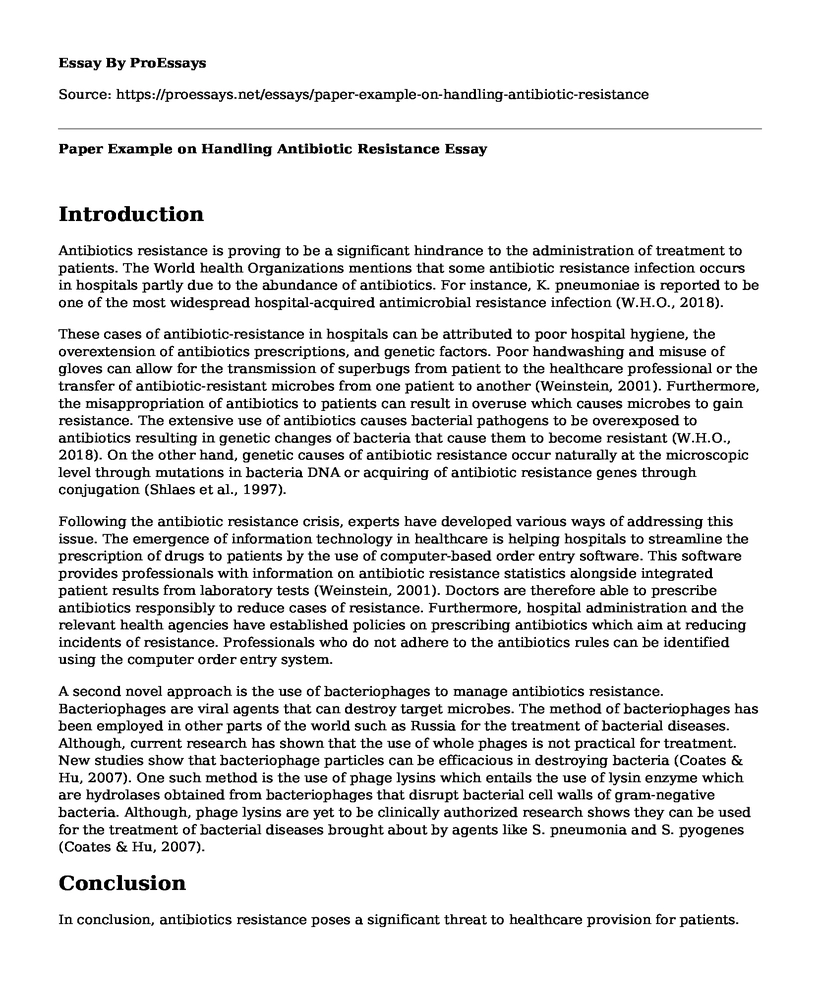Introduction
Antibiotics resistance is proving to be a significant hindrance to the administration of treatment to patients. The World health Organizations mentions that some antibiotic resistance infection occurs in hospitals partly due to the abundance of antibiotics. For instance, K. pneumoniae is reported to be one of the most widespread hospital-acquired antimicrobial resistance infection (W.H.O., 2018).
These cases of antibiotic-resistance in hospitals can be attributed to poor hospital hygiene, the overextension of antibiotics prescriptions, and genetic factors. Poor handwashing and misuse of gloves can allow for the transmission of superbugs from patient to the healthcare professional or the transfer of antibiotic-resistant microbes from one patient to another (Weinstein, 2001). Furthermore, the misappropriation of antibiotics to patients can result in overuse which causes microbes to gain resistance. The extensive use of antibiotics causes bacterial pathogens to be overexposed to antibiotics resulting in genetic changes of bacteria that cause them to become resistant (W.H.O., 2018). On the other hand, genetic causes of antibiotic resistance occur naturally at the microscopic level through mutations in bacteria DNA or acquiring of antibiotic resistance genes through conjugation (Shlaes et al., 1997).
Following the antibiotic resistance crisis, experts have developed various ways of addressing this issue. The emergence of information technology in healthcare is helping hospitals to streamline the prescription of drugs to patients by the use of computer-based order entry software. This software provides professionals with information on antibiotic resistance statistics alongside integrated patient results from laboratory tests (Weinstein, 2001). Doctors are therefore able to prescribe antibiotics responsibly to reduce cases of resistance. Furthermore, hospital administration and the relevant health agencies have established policies on prescribing antibiotics which aim at reducing incidents of resistance. Professionals who do not adhere to the antibiotics rules can be identified using the computer order entry system.
A second novel approach is the use of bacteriophages to manage antibiotics resistance. Bacteriophages are viral agents that can destroy target microbes. The method of bacteriophages has been employed in other parts of the world such as Russia for the treatment of bacterial diseases. Although, current research has shown that the use of whole phages is not practical for treatment. New studies show that bacteriophage particles can be efficacious in destroying bacteria (Coates & Hu, 2007). One such method is the use of phage lysins which entails the use of lysin enzyme which are hydrolases obtained from bacteriophages that disrupt bacterial cell walls of gram-negative bacteria. Although, phage lysins are yet to be clinically authorized research shows they can be used for the treatment of bacterial diseases brought about by agents like S. pneumonia and S. pyogenes (Coates & Hu, 2007).
Conclusion
In conclusion, antibiotics resistance poses a significant threat to healthcare provision for patients. Antimicrobial resistance can be caused by human error in hospitals or through genetic alterations in bacteria. Therefore there is a need for improved health practices in hospitals and implementation of novel methods of dealing with antibiotics resistance. Computer-based entry systems and the use of bacteriophage treatment can help to solve the antibiotics resistance crisis.
References
Coates, A. R., & Hu, Y. (2007). Novel approaches to developing new antibiotics for bacterial infections. British Journal of Pharmacology, 152(8), 1147-1154. doi:10.1038/sj.bjp.0707432
Shlaes, D. M., Gerding, D. N., John, Jr., J. F., Craig, W. A., Bornstein, D. L., Duncan, R. A., ... Watanakunakorn, C. (1997). Society for Healthcare Epidemiology of America and Infectious Diseases Society of America Joint Committee on the Prevention of Antimicrobial Resistance: Guidelines for the Prevention of Antimicrobial Resistance in Hospitals. Clinical Infectious Diseases, 25(3), 584-599. doi:10.1086/513766
W.H.O. (2018, February 15). Antimicrobial resistance. Retrieved from http://www.who.int/en/news-room/fact-sheets/detail/antimicrobial-resistance
Weinstein, R. (2001). Controlling Antimicrobial Resistance in Hospitals: Infection Control and Use of Antibiotics. Emerging Infectious Diseases, 7(2), 188-192. doi:10.3201/eid0702.010206
Cite this page
Paper Example on Handling Antibiotic Resistance. (2022, Aug 10). Retrieved from https://proessays.net/essays/paper-example-on-handling-antibiotic-resistance
If you are the original author of this essay and no longer wish to have it published on the ProEssays website, please click below to request its removal:
- Jones Memorial Hospital Case Study
- Personal Statement for Masters of Public Health at King's College London
- Endocrine Disruptors: Atrazine Paper Example
- Essay Example on Oxygen: Essential for Human Survival & Health
- Essay Example on Afraid to Die: HIV/AIDS Reality in South Carolina
- Mental Health Challenges in the COVID-19 Pandemic: 45% of US Adults Affected - Essay Sample
- Essay Example on Nutrition, Health & Learning: Why Investing Now is Vital for Our Future







